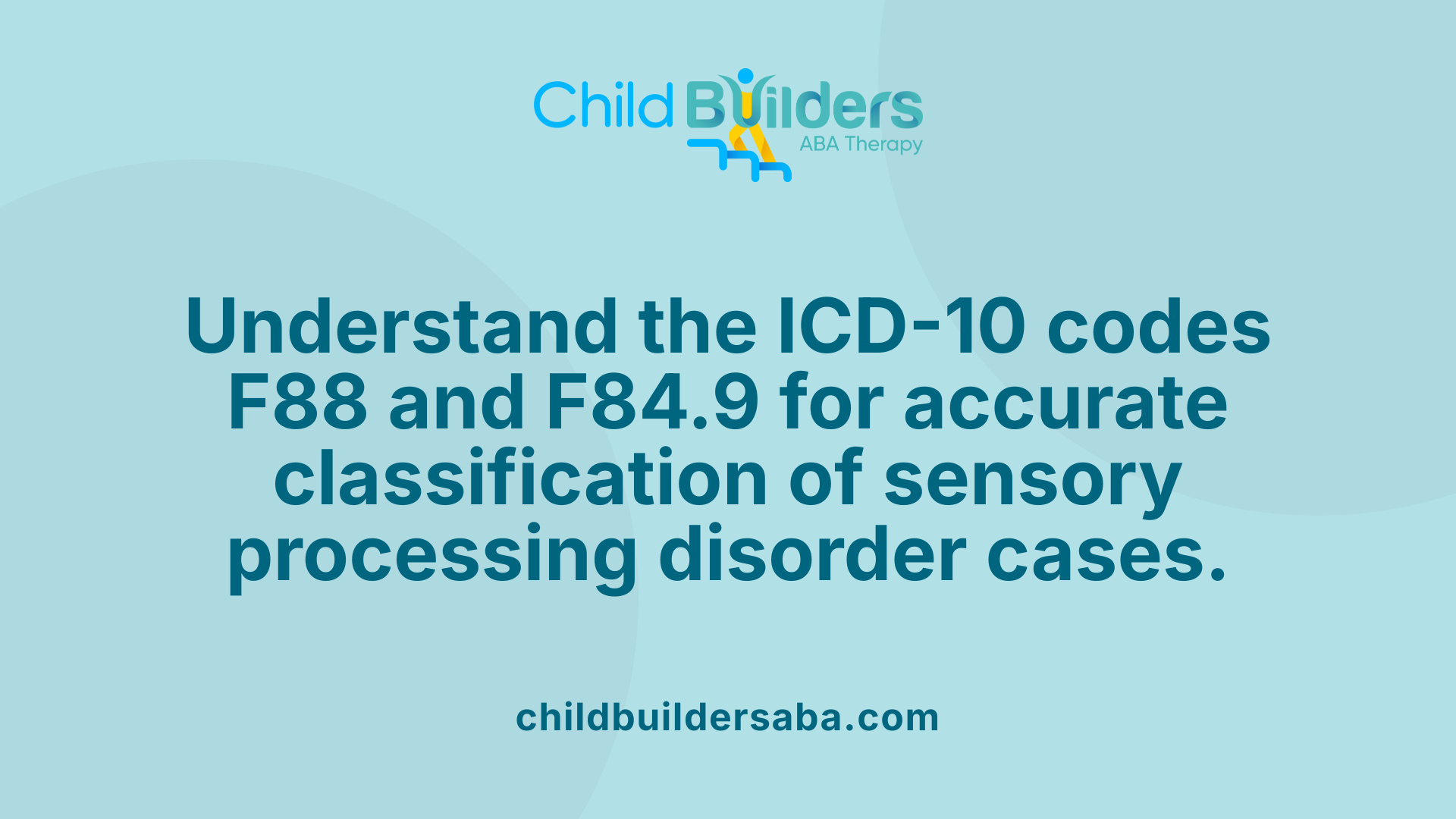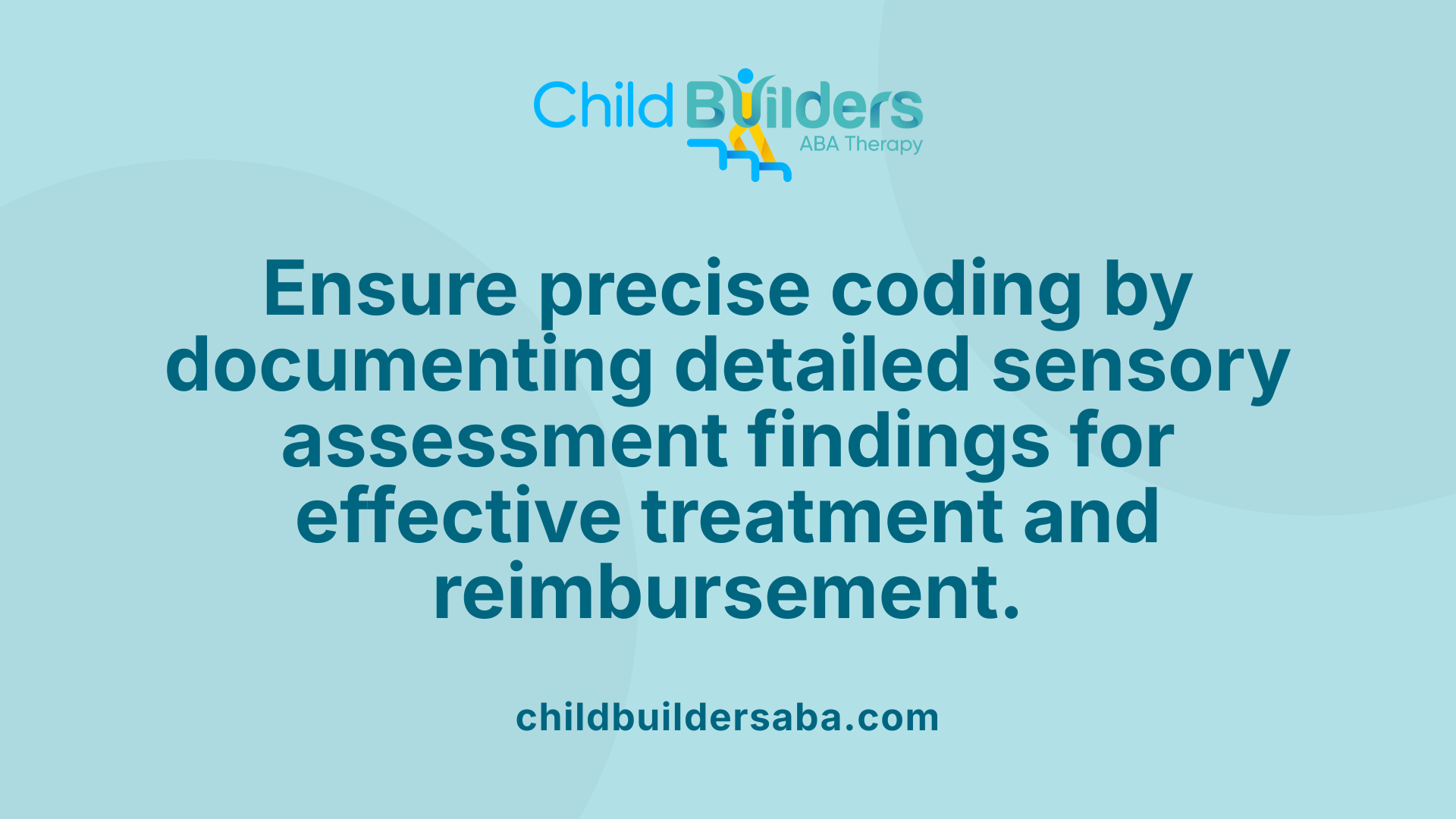What is the Sensory Processing Disorder ICD-10 Code?

Understanding How Sensory Processing Disorder Is Coded and Diagnosed in Healthcare Systems
Sensory Processing Disorder (SPD), also known as Sensory Integration Dysfunction, is a neurodevelopmental condition characterized by difficulties in processing sensory information, which can significantly impact daily functioning. While SPD is recognized clinically and within research contexts, its coding within the International Classification of Diseases, Tenth Revision (ICD-10), remains complex due to the lack of a dedicated, specific code. This article explores how SPD is classified under ICD-10, the importance of accurate coding for diagnosis, documentation, billing, and how clinicians can navigate this system for optimal patient care.
ICD-10 Classification of Sensory Processing Disorder

What is the ICD-10 code for Sensory Processing Disorder, and how is it classified within the system?
Currently, there is no specific ICD-10 code dedicated solely to Sensory Processing Disorder (SPD). Instead, clinicians use broader codes that encompass the symptoms and related conditions associated with SPD. The most relevant codes include F88, which falls under the category of "Other Disorders of Psychological Development," and F84.9, designated for "Pervasive Developmental Disorder, Unspecified."
F88 is generally employed when SPD occurs as an isolated condition without additional diagnoses such as autism spectrum disorder (ASD). This code is appropriate when sensory issues are documented as impacting daily functioning, and assessment results explicitly indicate sensory integration problems alongside normal cognitive functioning. Documentation should clearly specify sensory dysfunction and any related social or communication deficits to ensure proper coding.
On the other hand, F84.9 is used when sensory processing issues are part of a broader neurodevelopmental disorder, particularly when associated with ASD traits. This is common, given that a significant proportion of children with ASD (over 90%) also experience sensory processing difficulties.
Since SPD involves sensory modulation challenges—such as hyperesthesia (R20.3), hypoesthesia (R20.1), or paresthesia (R20.2)—clinicians also use more specific ICD-10 codes to document particular sensory symptoms or associated neurological concerns. Examples include R43.1 for smell disturbances, R43.2 for taste disturbances, or R27.9 for unspecific lack of coordination.
It is important to note that there is no overarching medical diagnostic code explicitly designated for SPD. This emphasizes the importance of precise documentation and the use of related codes based on the individual presentation of the disorder.
In clinical practice, utilizing the correct ICD-10 codes involves a thorough assessment by trained professionals, such as occupational therapists specializing in sensory integration. Proper coding ensures accurate reimbursement, compliance with health regulations, and clearer epidemiological data.
In summary, while there isn't a single ICD-10 code for SPD, clinicians rely on F88 for standalone sensory processing issues and F84.9 when these are part of or associated with broader neurodevelopmental conditions. Clear documentation of sensory dysfunction and associated social or communication deficits is essential in selecting the appropriate codes and supporting treatment documentation.
Broader Categories for Neurodevelopmental Disorders and Coding Practices
| ICD-10 Code | Description | Typical Use Cases | Additional Notes |
|---|---|---|---|
| F88 | Other Disorders of Psychological Development | Isolated SPD without ASD | Requires documented sensory issues affecting ADLs |
| F84.9 | Pervasive Developmental Disorder, Unspecified | SPD as part of ASD or broad neurodevelopmental diagnosis | Used when sensory issues are noted but do not meet full ASD criteria |
| G98.8 | Other neurological concerns | General neurological symptoms | Used for neurological symptoms linked to sensory issues |
| R20.3 | Hyperesthesia | Specific sensory hypersensitivity | Documenting sensory hyper-responsiveness |
| R20.1 | Hypoesthesia | Reduced sensation | When sensory responsiveness is diminished |
| R20.2 | Paresthesia | Abnormal sensation | Describes tingling or numbness |
| R43.1 | Smell sensory disturbance | Sensory disturbance related to smell | For smell-related sensory problems |
| R43.2 | Taste sensory disturbance | Disturbances in taste sensation | For gustatory sensory issues |
| R27.9 | Unspecific lack of coordination | Motor coordination issues | When coordination problems are present without specific diagnosis |
| R27.8 | Other lack of coordination | General coordination issues | Broadly used for motor deficits |
| R27.0 | Ataxia | Loss of full control of bodily movements | For cerebellar or motor ataxia |
| H53.10 | Visual disturbance | Visual sensory issues | When visual processing is affected |
Understanding the proper use of these codes enhances accurate diagnosis documentation and treatment planning. It also helps in complying with insurance and billing requirements, ensuring that children with sensory processing issues receive appropriate care.
This classification underscores the importance of detailed clinical documentation. Proper coding based on comprehensive assessment helps support ongoing research, treatment, and understanding of sensory processing disorders within the broader framework of neurodevelopmental conditions.
The Role of ICD-10 Coding in Clinical Practice and Healthcare Management

How does ICD-10 coding facilitate diagnosis, documentation, and billing for Sensory Processing Disorder?
ICD-10 coding plays an essential role in accurately identifying and managing Sensory Processing Disorder (SPD) in clinical settings. For cases of SPD without comorbid autism, the ICD-10 code F88 is used. This code, categorized under 'Other Disorders of Psychological Development,' ensures that healthcare providers can document sensory integration issues distinctly from other neurodevelopmental disorders.
When SPD is part of a broader neurodevelopmental diagnosis, such as Autism Spectrum Disorder, clinicians often use the F84.9 code, which indicates a pervasive developmental disorder, unspecified, to reflect overlapping symptoms. Proper use of these codes hinges on detailed documentation, including assessment results and specific sensory dysfunctions impacting daily activities.
Accurate coding supports a clear diagnosis by capturing the functional impairments caused by sensory processing difficulties. It also facilitates communication among multidisciplinary teams involved in a child's care.
From a billing perspective, ICD-10 codes directly influence reimbursement processes. When documentation explicitly mentions sensory issues and related social or communication deficits, claims are more likely to be accepted without delays or denials. Use of precise codes like F88, supported by documentation such as sensory assessments and clinical notes, streamlines billing and ensures compliance with insurance requirements.
While no singular medical diagnostic code for SPD exists universally, ICD-10 codes such as F88 effectively depict the diagnosis within clinical and billing contexts. This system of coding enhances clinical accuracy, promotes consistent documentation practices, and supports the management of sensory processing challenges in healthcare settings.
Understanding the importance of proper coding helps healthcare providers deliver targeted interventions, such as occupational therapy tailored to sensory integration needs, and ensures that necessary services are reimbursed fairly. Furthermore, standardized coding enriches data collection, enabling better research, epidemiology, and resource allocation for SPD-related services.
ICD-10 Codes Related to Sensory and Auditory Processing Issues

What are the common codes related to sensory processing or auditory processing issues within the ICD-10 system?
In the ICD-10 classification, there are several codes used to identify sensory and auditory processing problems. For sensory processing disorders specifically, the code F88 is used when the condition is documented as an individual disorder of psychological development, especially in cases without autism. If SPD is part of a broader neurodevelopmental disorder like autism, the appropriate code shifts to F84.9, indicating Unspecified Pervasive Developmental Disorder.
For auditory processing challenges, one of the central codes is H93.25, which corresponds to Central Auditory Processing Disorder (CAPD). This condition involves difficulty understanding and processing sounds despite normal hearing ability. Similarly, R48.2 is used for Apraxia, which impacts speech sound production and can affect auditory processing.
Broader speech and language impairments related to sensory issues are categorized with codes like F80.0 for Phonological Disorder and F80.1 for Expressive Language Disorder. These conditions often overlap with sensory processing problems and are essential for a comprehensive diagnosis.
Accurate coding is crucial for proper diagnosis, treatment planning, and reimbursement. It also helps clinicians document specific deficits—whether in auditory processing, language, or sensory integration—leading to targeted intervention strategies.
Below is a summary table listing these codes and their associated conditions:
| ICD-10 Code | Condition | Description | Related Sensory Modalities |
|---|---|---|---|
| F88 | Other Disorders of Psychological Development | Standalone sensory processing disorder without ASD traits | General sensory modulation |
| F84.9 | Pervasive Developmental Disorder, Unspecified | When SPD is part of broader neurodevelopmental disorders like autism | Autism spectrum traits |
| H93.25 | Central Auditory Processing Disorder | Difficulty processing auditory input | Hearing and auditory processing |
| R48.2 | Apraxia | Motor planning difficulty affecting speech and auditory comprehension | Speech and motor skills |
| F80.0 | Phonological Disorder | Problems understanding or producing speech sounds | Speech sounds |
| F80.1 | Expressive Language Disorder | Challenges with expressive language, often linked to sensory issues | Language production |
Utilizing the correct codes and detailed documentation ensures that healthcare providers can accurately classify and address the sensory and auditory challenges present in their patients.
Best Practices for Proper Coding and Classification of SPD

What are best practices for properly coding and classifying Sensory Processing Disorder for medical documentation and billing?
To ensure accurate coding and classification of Sensory Processing Disorder (SPD), clinicians must provide detailed documentation of the patient's symptoms, assessments, and how these impact daily functioning. Since no specific ICD-10 code exists solely for SPD, coding relies on related classifications.
Accurate documentation should explicitly describe sensory dysfunctions, such as hypersensitivity or hyposensitivity, and include results from standardized assessment tools like the Sensory Profile or Sensory Processing Measure. These assessments help validate the diagnosis by providing measurable evidence of sensory modulation difficulties.
It is important to link sensory symptoms to their effects on social interactions, communication, and daily activities. For example, notes should specify how sensory issues interfere with participation at school or home.
When coding, clinicians should select F88 (Other Disorders of Psychological Development) for isolated SPD cases without autism or other neurodevelopmental disorders. If SPD co-occurs with broader conditions like autism spectrum disorder, the appropriate code is F84.9 (Pervasive Developmental Disorder, Unspecified).
Supporting documentation must meet clinical validation criteria, including detailed assessment results and descriptions of sensory and functional impairments. Clear, specific documentation ensures proper reimbursement and compliance, reducing the risk of billing errors or denials.
Ultimately, thorough and precise reports linking clinical findings to functional impacts are essential. Using standardized assessment tools and explicit descriptions allows clinicians to correctly identify the appropriate ICD-10 codes, supporting effective treatment planning and accurate billing practices.
Ensuring Accurate Coding and Diagnosis of Sensory Processing Disorder
Accurate coding of Sensory Processing Disorder within the ICD-10 framework remains essential for effective clinical management, insurance reimbursement, and epidemiological data collection. While there is no dedicated code for SPD, using related codes like F88 and F84.9, supported by detailed clinical documentation, ensures that healthcare providers can communicate diagnoses clearly and pursue appropriate treatment pathways. Proper documentation that details sensory symptoms and their impact on daily functioning not only aids in clinical validation but also helps avoid coding pitfalls and billing issues. As research advances, and awareness grows, the ICD-11 continues to work toward offering more precise classifications for sensory processing conditions, but for now, clinicians must rely on existing broader neurodevelopmental codes to accurately reflect their findings.
References
- Sensory Processing Disorder - ICD-10 Documentation Guidelines
- Physician Resources - Ohana OT Pediatric Therapy in Wenatchee
- Crosswalk from DC:0-5™ to DSM-5 and ICD-10 - Zero to Three
- Sensory Integration Disorder - ICD-10 Documentation Guidelines
- Sensory processing disorder - TheraPlatform
- Sensory processing disorder - TheraPlatform
- [PDF] Billing and Coding Occupational Therapy for Mental and Behavioral ...



.jpg)

































































































